This is a draft of what will likely become a book detailing how our minds form culture based on shared experiences and a Nash-like equilibrium of cultural dynamics.
Perceptual + Narrative Zones #
Perceptual Zones #
Each individual (an agent) has their own perceptual zone which differs from other people’s perceptual zones. The perceptual zones may overlap, but in many case they don’t. The perceptual zone is the combined whole of experience each individual is perceiving and sense-making at any given time.
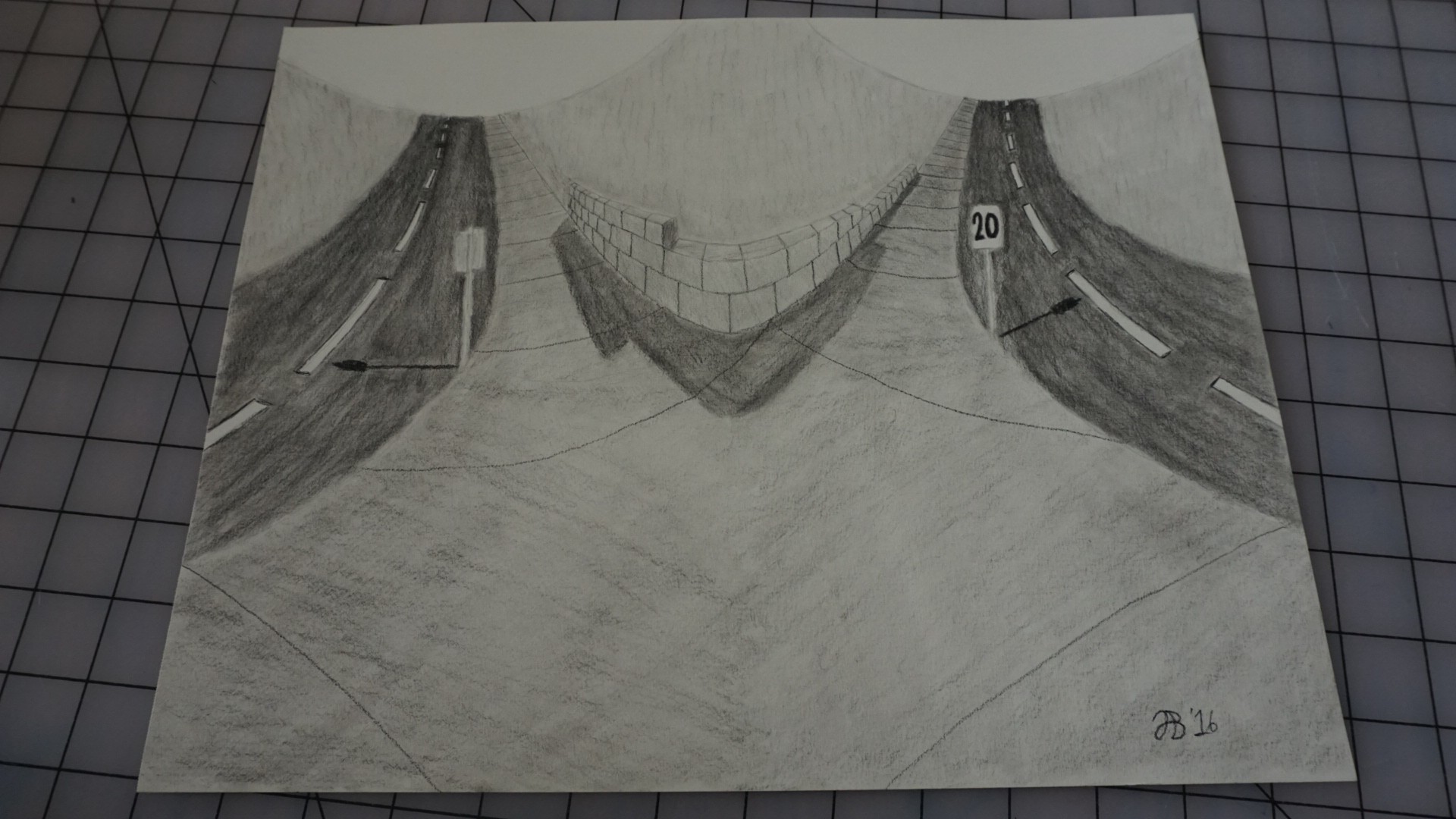
Image 1
Two visual perceptual zones looking towards each other and overlapping
There are at least two principal divisions of perceptual zones: Interior + Exterior. These different zones are also supported by the concepts of external and internal focalization in literature.
The exterior division is that created by the senses, presumably, which is possible to experience together with someone also physically present and presumably caused by a physicality (but could potentially be caused by a defect in perception, i.e. an illusion): brightness, color, smell, taste, texture, temperature, touch, movement, loudness, frequency, etc. It should be obvious that this is not necessarily entirely shared by all people, since some people lack color perception or visual perception entirely, some people cannot hear, etc.
The interior division is created by the mind reacting to the stream of input created by either the exterior perception, the imagination, or other feedback loops within itself: imagination, emotions, thoughts, inferences, anything one experiences which isn’t readily accessible or perceivable to a one whom is not a mind reader.
Usually, human’s integrate perceptual zones into narratives. Narratives of stories are typically easy to remember.
Forming Narratives #
Every person is selective in what they choose to pay attention. Each person will create a different narrative about the events going on around them. Each person also has their own internal perceptions of their own internal state. A person forming a narrative about someone else will only draw upon the external qualities they perceive about someone else, unless there has been some interaction that allowed them to know another person’s interior state. If someone were able to only focus on external qualities and happenings, without any interpretation of those qualities and happenings and without implying anything, they might come to a very objective description of their limited view. In writing, this is known as external focalization. However, very rarely does anyone’s narrative about an experience happen in external focalization. Typically, it also includes a host of feelings, internal state, and assumptions about other people’s’ internal state. Objective descriptions about what is going on can have an interesting effect, but it doesn’t read like internal thoughts.
This is an example of external focalization:
Three ladies stood up after having sat and talked around a large, wooden table. The table’s wood stain was worn and fading from its age. The ladies had talked for over an hour. As they were walking towards the door, the barista called out, “See you all later.” They all waved, and continued talking as they walked. The three ladies walked out the coffee shop door and rounded a corner of the shop. They walked on a sidewalk bordered by rocks and a patch of grass and continued around around the other corner. They continued out to the parking lot next to the boardwalk along the docks.
A giant fabric sign saying “ESPRESSO” in curvy all-caps waved in the breeze. Along the other side of the boardwalk, an American flag, US Army flag, US Navy flag, and US Marine flag all waved in a line. A lady wearing a blue shirt and black exercise crops walked a dog. They passed by on the other side of the window. The whole time I sat in my chair, wearing my green shirt, surrounded by my phone, tablet, battery pack, laptop, and camera all atop the wooden table.
It is purely descriptive of the physical world and the readily perceivable. The compliment to this would be internal focalization. It would be filled with emotions, thoughts, and ideas of what might be going on inside another’s mind. For example:
I am in a small coastal town in Oregon. I want coffee and a space to turn that coffee into words for my blog. I remember my last visit to this same town and the decent coffee shop I discovered by the harbor. As I drive there in the fog, I ponder what I’ll write. I am distracted by my enjoyment of the fog. It’s a nice break from the heat I just came from. I roll down my windows and expose my face to the cool moisture outside.
I arrive and notice a inflated tube of fabric flailing about in the wind around the corner from the shop. Wondering if those things do anything to grab people’s attentions, I walk around to other side of the building. As I open the door and enter, I take in the scent of the coffee beans. The smell is enough to start invigorating me. This is now my second time visiting this year and I’m becoming used to this place and its wooden furniture. I feel I’m likely to return many times.
I move to the counter to order. The barista is fumbling around trying get a few things in order behind the counter. I remember her as the barista that never talked to me last time. I can’t tell if she’s an introvert or if she just doesn’t like me. I’m not quick to judge. It might take a few more visits before she warms up to me. Eventually, she notices me and with a cold distance asks what I’d like. .I order my latte and oatmeal. I reach to grab my wallet out of my bag, but it’s not there. I left my wallet back in my car. I explain this hoping she won’t get upset with me. Fortunately she seems fine with the mishap. I leave to fetch my wallet and come back.
I return and enter through the only door. There are two people impatiently waiting for her to even acknowledge their presence. They pace back and forth as though they might leave. After a short while, she notices me standing to the side of the counter and goes to enter my order into the register. She comes back and tells me my total. I hand her a twenty dollar bill and she fetches my change. The others are still waiting.
Finally, she takes their order and payment. She finishes up their drinks fairly quickly. Once they step outside, she starts reading her book. I start thinking maybe she’s not the greatest with customer service or making use of down time to organize what she’ll need. While I’m observing all this, I unpack my digital goodies and set them haphazardly about me. A little disorganization helps me start writing.
This internal narrative ascribes motivations and starts hinting towards goals for each agent in addition to outlining the state of mind and emotion of the agent described. It takes some of the guesswork out of why certain agents actions are what they are. On the other hand, it could also be used to highlight the different thought processes each agent possesses. It can also be used to create tension or conflict by having characters ascribe incorrect motivations, reasons, or other driving factors to the other characters actions.
Now imagine if we could take two narratives about the same situation from different perspectives, both with internal focalization, and lay them side by side. We could see how they differ by how far away the lines are from each other. The closer the lines are, the more alike the perceptions are and the less likely conflict is to arise. The farther they are apart, the more different the perceptions are. We could even add a layer of external narratives in between the two internal narratives to see the differences in what each person experiences in the scene that others might also observe.
Imagine others’ experiences sitting in the coffee shop with me. Some are travelers, while some are locals and regulars. All of them arrive at the shop and observe a subset of the same environment. Some of them might be self absorbed, others might be more focused on what is going on outside, and others might be focused on the other people in the room. We are all in the same location, there’s a bit of commonality there. Because of the selectivity of their attention, these experiences differ. Each person notices different aspects of the environment and would accentuate those bits in writing an objective description of their experience. Each person also has their own mental place and reason for being there. When people come to the same geographic location and the same room, their narratives get closer together in some dimensions — if they’re paying attention to those dimensions.
One person might be at the coffee shop to focus on reading. Another couple might be getting a cup of coffee to wake them up while going on a walk. Others might be there to catch up over a cup of coffee. In many of the situations, the physical space is not as important as the function the coffee serves in their plans for the day or the closeness of the group’s interactions.
If we lay these individual strands of narrative beside one another, we’ll find a few different patterns. All of these individual strands of narrative get closer together once they enter the coffee shop. If the group of people sitting at the table conversing came from different places, their stands would start out further apart and begin to converge and become close to, but distinctly separate, from the other strands of narrative. Their individual experiences would be woven into narratives more similar than other narratives in the same room. Their narratives would be distinctly different from mine. I was just sitting down by myself to write my thoughts down. Their narratives would also be different from the lady behind me reading a novel, just that lady and my narrative differ by our action in the coffee shop.
Narrative Diagrams #
Now that we’ve properly outlined the meaning and context behind the internal and the external narratives, these two strands can be used to weave a narrative diagram for one agent:

Figure 1
The main states any pair of narratives can occupy are either consonant or dissonant. The relative amount of space between narratives indicates the amount of consonance or dissonance. Sometimes there can be conflict between an agent’s internal narrative and external narrative, as indicated by dissonance between the two narratives. This is created through divergence between internal and external narratives, optionally any number of “false” narratives may be present.
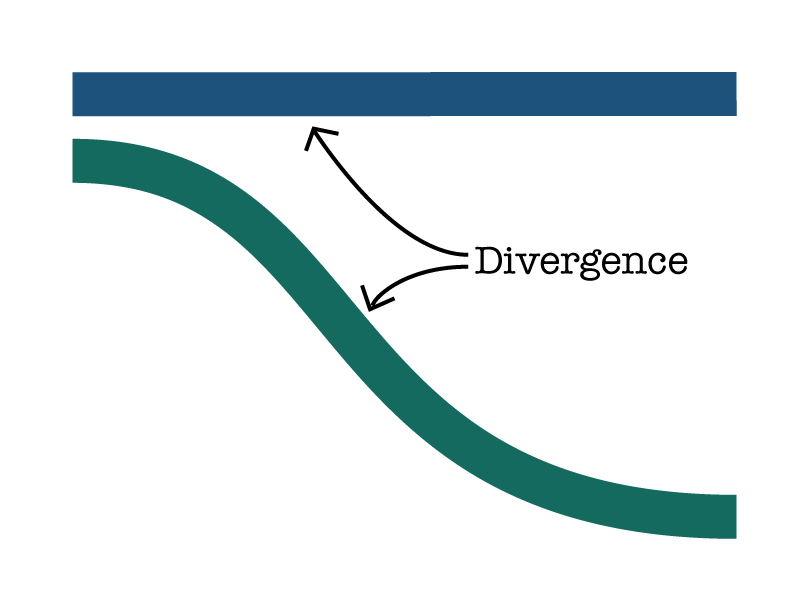
Figure 2
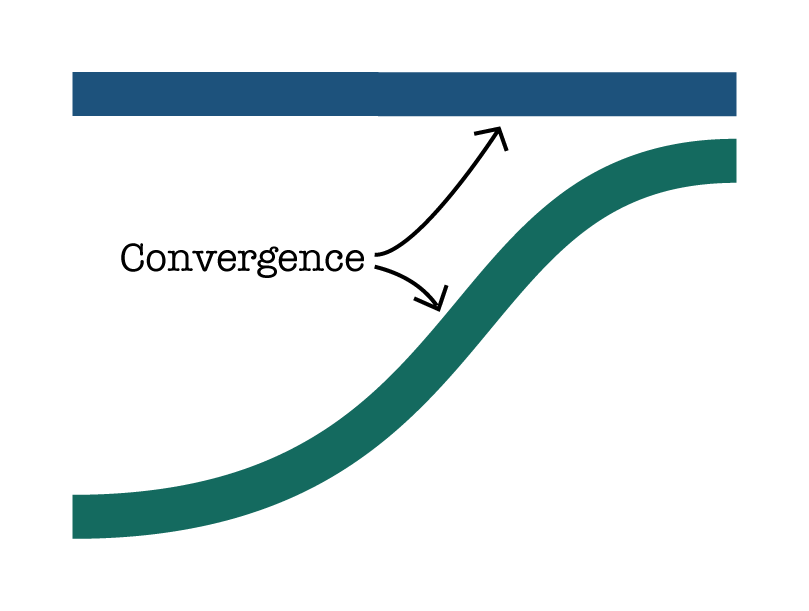
Figure 3
When two narratives go from being consonant to being dissonant, they are said to diverge. When two narratives go from being dissonant to consonant, they are said to converge. This is represented in the diagram as divergence (Fig. 3) and convergence (Fig. 4).
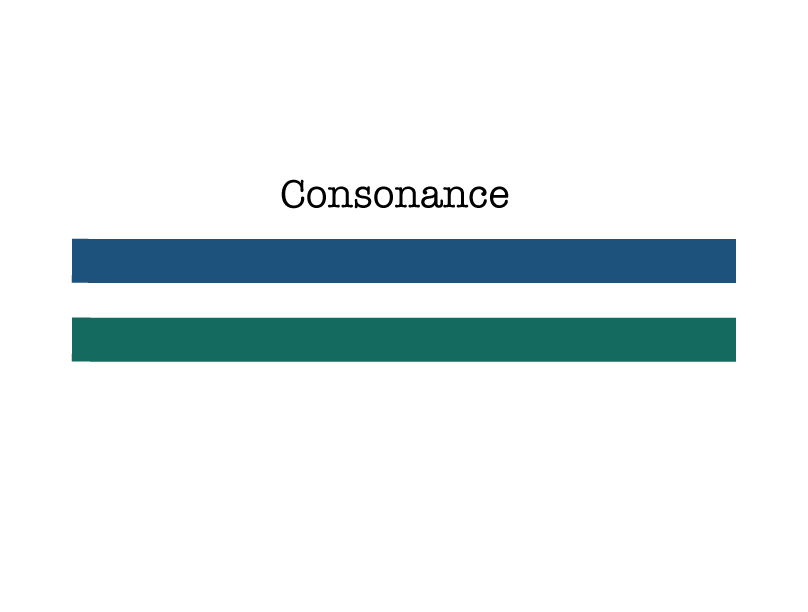
Figure 4
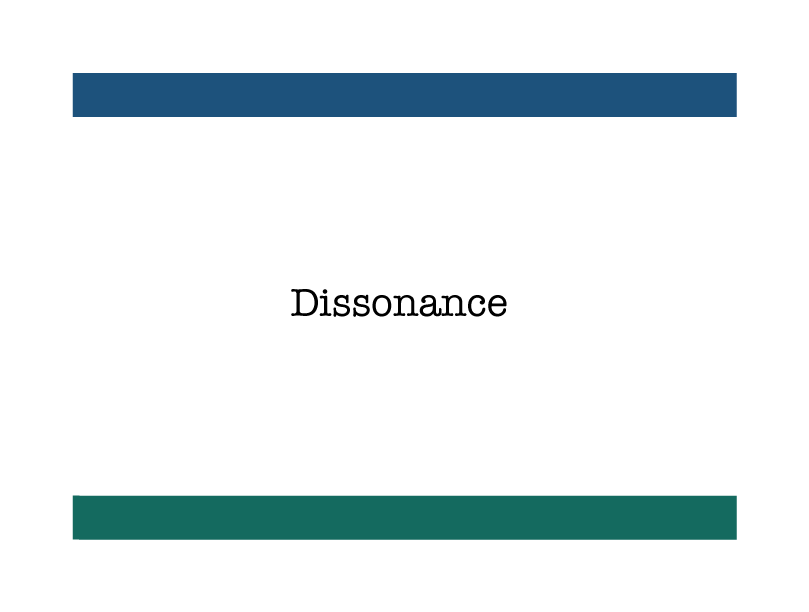
Figure 5
Different kinds of false narratives can happen. A false narrative can either be congruent to one of the narrative strands or it can be congruent to none of the narrative strands. Typically it’s defined as being false compared to the internal narrative (an agent’s primary source of self- knowledge) or false compared to the reality and self-knowledge, as in Fig. 7, where it’s divergent and dissonant with both internal and external narratives.

Figure 6
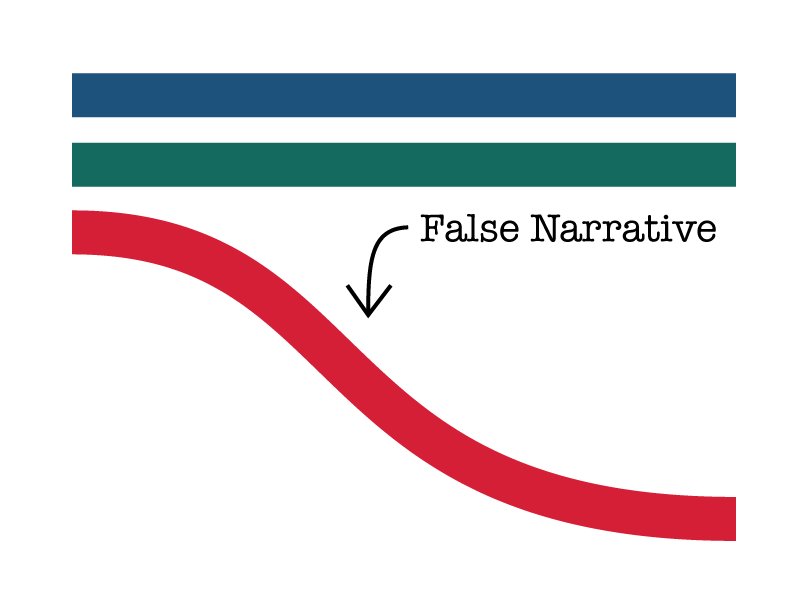
Figure 7
An aspect of this way of diagramming situations is each of these diagrams lacks explicit detail and can represent many different situations. What it brings is a way of diagramming the spaces certain actors and relationships occupy – it can emphasize the distance between mental space and physical space of both. Before delving into the ways this demonstrates relationships with others let us examine how it can demonstrate relationship with self.
In Fig. 1, the agent’s internal narrative and external narrative stay consonant and track one another as they both change. They could be riding a horse at a fast clip and their mind doesn’t wander, but stays in a flow monitoring their environment as close as possible.
Fig. 4 shows the agent’s internal and external narratives diverging. No “false” narrative is created in this case. This could be someone working on a hard problem at their computer, whiteboard, or couch, then leaving for a walk but their mind remains focused on the same problem, more distant from their immediate surroundings. Perhaps they were dreaming about taking a trip to place far away, arriving at the airport though they were still waiting in line to order lunch. Perhaps a tragic accident occurred and they are in shock or denial. Perhaps they went through puberty and look and act like a typical straight person, but despite what anyone else thinks, they are actually not straight and they make no attempt to mask that, but they don’t “code” for it either.
Fig. 5 shows the agent’s external narrative converging towards their internal narrative. This could indicate they were at work, but day dreaming of going and buying the latest Allen & Heath studio mixing console for their studio they also own and use during the weekends. Then as they leave work and go buy the mixing console, their external narrative comes into consonance with their internal narrative.
Fig. 6 is interesting because it diagrams an agent for whom an internal narrative has diverged from their external narrative (or v.v.), while they have created a separate internal narrative to match the external narrative, or, rather, to match what they believe other agents’ internal narratives are for a corresponding external narrative. In contrast to this is Fig. 7, which is an outright lie created knowing full well what one’s external narrative is and actually being in agreement with it. The relationship of self to the perceivable worlds is incongruent in the case of Fig. 6, but the relationship of the false narrative is dissonant to the perceivable reality in Fig. 7.
Fig. 6 represents a life lived inauthentically or a moment where other’s impressions become the driving force. An example of this archetype would be someone “in the closet”. Perhaps they married someone they were expected to marry even if they were never sexually attracted to them. Perhaps they are transsexual and are living the role assigned to them at birth. In order to accomplish this, they have created a “false” narrative which is in great conflict with their internal narrative which is also dissonant with the perceivable reality (the external narrative). This places a great strain on an individual.
This could also represent the beginning of stereotype threat, where one’s internal narrative is quite different from what someone expects of you and you let their stereotypical projection onto you drive a false narrative. This may resolve itself quickly, or it might drive tensions with self for a while.
How do these strands of narrative interact with other people’s strands of narrative? This is where it gets interesting, because there are quite a few combinations. The basics are the same as laid out above. Instead of just one internal and external narrative, there become as many pairs as there are agents.

Figure 8
Two agents’ external narratives overlap in a shared perceptual field
Fig. 8 represents two people coming into the other’s perceptual fields, sharing part of their physical reality, but not much of their inner reality. This is the equivalent of the visual field overlap illustrated in Image 1. Two fields of perception come close enough that there is enough information to map one onto the other, even if imperfectly. There’s a lot of potential variation in these diagrams, especially if the inner narrative is allowed to cross over the external narrative to allow for people building similar thoughts and inner narratives.
The full set of possibilities is derived through the following rules:
- Apply one operation of:
- Diverge
- Converge
- Transpose
- Account for symmetries between the two agents to remove redundant relationships:
- If the two agents can be transposed and it results in the same relationships between agents, then the state is symmetric.
- Clusters of consonances are typically always symmetrical, except that external narratives always represent a division into individuals so the order of the cluster does matter, since a transposition of the internal narrative across the external narratives is not symmetrical.

Figure 9
The derivation of the 13 possible states from the rules described above
These configurations represent the following 13 states:
Two agents with external experiences which are closely congruent with one another. Their internal narratives are consonant with their external narratives, but they may be thinking of different things.

This is a fairly common situation. It describes two people who have nearly overlapping spheres of perception, but yet are thinking about things which are different, yet may still reference the same objects in the possibly overlapping areas of their environment. This could be two people sitting at a counter in the same bar. They might even be talking to each other, but they haven’t yet reached the state where their minds are closer than their bodies, as in j.
Two agents with external narratives which are dissonant with one another. Their internal narratives are congruent with their external narratives, but they are definitely having different experiences.

Wašté Wiŋ is riding her horse through a field completely engrossed in the glory of the shining sun at near noon and and the medicine she flys over while navigating the 6 directions. Her brother is sitting in a couch hidden in the shadows of their home’s basement playing video games, he is similarly in a state of flow [but this narrator doesn’t think it’s as healthy].
Two agents with consonant external narratives. One agent’s internal narrative is consonant with their external narratives, while the other agent’s internal narrative is dissonant with the all other narratives.

Harriet and Oscar sit in their Scion as it glides across the mountain highway. Soon they will be at their destination. Harriet sits ponderously distant in the passenger seat while Oscar is immediately present taking curve around the mountain with ease.
Two agents with consonant external narratives. Each agent’s internal narratives are dissonant with their external narratives.

Jillian and Sky sit side by side at the coffee shop. Though they are best friends, they have separate lives and each is focused on their tasks and emails whose invisible ties link them to friends and colleagues far away.
Two agents with dissonant external narratives. One agent’s internal narrative is distinctly dissonant with their external narrative. One agent’s internal narrative is consonant with their external narrative.

Far away from his sister Tiffany, Arnold is engrossed in World of Warcraft so much so he forgets about how much his butt and bladder actually hurts from sitting so long focused on the virtual campaign he’s leading. Meanwhile, Tiffany is practicing yoga a state away, focusing on every bodily sensation and breath.
Two agents with dissonant external narratives. Each agent’s internal narratives are also distinctly dissonant with their external narratives.

Jasmine reclines in her hammock in Mars Colony One’s residence hall. She is dreaming of the vast cosmos and the most recent fast radio burst (FRB) which was detected. She ponders if there is another intelligence here in the universe. Meanwhile back on Earth her distant cousin Marta is laying on the reddish-brown clay soil next to the river and the red willows which surround her in her Nevada homelands. Her mind is thinking about how all of life is one organism, still sharing most of its original DNA and RNA, constantly searching out new forms and ways of being. She realizes she is just one branch of the tree turned sideways in time which we call humanity. Each part has something to offer and something to learn from every other part – if we can really call anything an “other”.
Two agents with consonant external narratives. Their internal narratives are more consonant with each other than their external narratives.

Eugene and Jackie are naked in bed on top of each other. Their minds are just as entwined in each other as their bodies are, each thinking of how in the moment to best pleasure the other. Their bodies writhe together in undulating passion.
Two agents with dissonant external narratives. Their internal narratives are consonant with each other and consonant with one external narrative.

Jared is a remote client joining a conference with Tina, the lead architect. She is screen sharing her laptop screen while she sits in an office conference room talking about the building design on her screen. Both are focused on what’s going on in the conference room, and not what’s happening at Jared’s physical location.
Two agents with consonant external narratives. Their internal narratives are consonant with each other, but dissonant from their external narratives.

Mario and Luigi are playing their Sega Genesis, each embodying their in-game characters while they both sit on the couch. Both of their minds are occupied by the same in game experiences, while their bodies also share the same physical environment.
Two agents with dissonant external narratives. Their internal narratives are more consonant with each other, but dissonant from their external narratives.

Janet and Manuel are each in different states on their distinct couches playing Second Life. They happen to be chatting in game at a bar. They haven’t seen each other in a long time and are excited to catch up, even if it is just virtually.
Two agents with dissonant external narratives and dissonant internal narratives. One agent’s internal narrative is more closely consonant with the other agent’s external narrative.

Justine, a web developer, sets up a livestream of herself coding. While she may be sitting in front of a computer programming, most of the abstract concepts she grapples with are very distant from the physical plane. Chris, who is not familiar with programming at all, tunes into the livestream to watch and get away from the worries of his life and puzzles over the livestream of someone typing at a desk before switching from YouTube to ESPN.
Two agents with dissonant external narratives and dissonant internal narratives. Both agent’s internal narratives are consonant with the other agent’s external narrative.

Chadricia and Patwyn are are performing an experiment with VR and telepresence over Internet2. They are each in different countries: Chadricia is in London, UK while Patwin is in California, USA. They each wear a VR headset with a camera and x-y microphone setup. Instead of augmented reality where each person’s perception is modified and then fed back to the same person, they are experiencing each other’s perspective instead of their own.
Two agents with consonant external narratives and dissonant internal narratives. Both agent’s internal narratives are consonant with the other agent’s external narrative.

Bianca wakes up next to her newborn son she just slept with outside her body for the first time, but realizes she is experiencing all the bodily sensations of her newborn and feels her own body pressing up against the tiny body she is experiencing. She thinks to herself, Could my baby be experiencing a dream of being older and having my form?
Enumerating the transitions from each option to the next option, will not be undertaken in the present work, but it does enumerate to 78 (13 choose 2) possible transitional archetypes of movements through both internal and physical space. As the magnitude of the changes can differ, this offers a near infinite amount of variety.
A Deeper Look at False Narratives #
False narratives are narratives which are inserted between internal and external narratives (between self) or between external narratives (between selves). In other words, a false narrative can be about internal conflict and inauthenticity to self (type a) or lies (type b). The list of situations which fall under type a is staggering.
Each of the diagrams presented above leave out any mention of false narratives. This is because including them would complicate matters and make the archetypes even harder to understand. However, wherever there is divergence/dissonance between two agents or divergence/dissonance between one agent’s internal and external narrative, a false narrative can be inserted. This means that a subset of seven of the diagrams [c,b,d,e,f,k,l] can be easily mutated to include one or more false narratives.
What about false beliefs? Can these be represented in these diagrams? A false belief would be woven into the the fabric of one’s internal narrative regardless of any external narrative past of present. This would manifest itself is as a rift between internal narratives, one containing the false belief and one not containing the false belief, in a conversation where a counterexample to the false narrative is not present in consonant external narratives. It could also manifest itself as a divergence between an internal narrative containing the false belief and consonant internal and external narratives containing a counterexample to the false belief. Agents who do not hold the false belief, but an internal narrative holding a belief in harmony with their external narrative containing a counterexample negating the false belief may be able to highlight the false belief in a diagram by diagramming a false narrative which is co-divergent and consonant with the narrative containing the false belief.
There is a structural similarity between false narratives and narratives containing false beliefs — diverging internal narratives, possibly also diverging from an external narrative — a false belief is labeled with with a false narrative which is consonant with the internal narrative containing the false belief; while a false narrative corresponding to a stereotype threat, internal conflict, or inauthentic life is consonant with the external narrative or other agents’ internal narratives. In essence, a stereotype threat is one labeling others internal narratives as containing false narratives. This is probably why these situations can be so difficult to speak of in detail. It becomes an us vs. them situation. In some cases, the facts in the external narratives have no correlation to the nature of what or whom is observed despite an internal narrative specifying a false correlation. This is an example of what can lead to stereotype threat. In other cases the internal narrative holds onto a belief which is completely counterfactual. This would be the difference between a man falling to peer pressure or a stereo type threat and playing basketball instead of going into music and a Mexican being a good person despite Trump’s lies about all Mexican’s being criminals.
- Damasio A (2011) The quest to understand consciousness. TED2011.
- Gilbert D (2011) The Social Psychological Narrative, or, What Is Social Psychology, Anyway? Edge Conversation. June 7.
- Wilson TD (2011) Redirect: the surprising new science of psychological change. New York, NY: Little, Brown and Company.
- Popova M (2011) Redirect: A New Way to Think About Psychological Change. Brain Pickings. September 9.
- Schultze U, Leahy MM (2009) The Avatar-Self Relationship: Enacting Presence in Second Life. ICIS 2009 Proceedings. 12.
- Boroditsky L. Entire Research
- Boroditsky L. How language shapes the way we think
- Alvarez-Melis D, Jaakkola TS. Gromov-Wasserstein Alignment of Word Embedding Spaces. arXiv:1809.00013 [cs.CL].
- Lou J, Cao Y, Barzilay R (2019) Neural Decipherment via Minimum-Cost Flow: from Ugaritic to Linear B. arXiv:1907.06718 [cs.CL].
- Matheson R (2018) Model paves way for faster, more efficient translations of more languages. TechXplore. October 31.
- Smith K (2011) Learning Bias, Cultural Evolution of Language, and the Biological Evolution of the Language Faculty. Human Biology. 83(2): 261-278
- Sandler W (2018) The Body as Evidence for the Nature of Language. Frontiers in Psychology. 9: 1782.
- Sandler W, Aaronoff M, Meir I, Padden C (2011) The gradual emergence of phonological form in a new language. Nat Lang Linguist Theory. 29(2): 503-543.
- Sandler W, Meir I, Padden C, Aaronoff M (2005) The emergence of grammar: Systematic structure in a new language. PNAS. 102(7): 2661-2665.
- Langus A, Mehler J, Nespor M (2017) Rhythm in Language acquisition. Neuroscience & Biobehavioral Reviews. 81-B: 158-166.
- Goldin-Meadow S, Yang C (2017) Statistical evidence that a child can create a combinatorial linguistic system without external linguistic input: Implications for language evolution. Neuroscience & Biobehavioral Reviews. 81-B: 150-157.
- Crain S, Koring L, Thornton R (2017) Language acquisition from a biolinguistic perspective. Neuroscience & Biobehavioral Reviews. 81-B: 120-149.
- Yang S, Crain S, Berwick RC, Chomsky N, Bolhuis JJ (2017) The growth of language: Universal Grammar, experience, and principles of computation. Neuroscience & Biobehavioral Reviews. 81-B: 103-119.
- Del Giudice A (2012) The emergence of duality of patterning through iterated learning: Precursors to phonology in a visual lexicon. Language Cognition. 4(4): 381-418.
- Verhoef T (2012) The origins of duality of patterning in artificial whistled languages. Language Cognition. 4(4): 357-380.
- Verhoef T, Kirby S, de Boer B (2015) Iconicity and the Emergence of Combinatorial Structure in Language. Cognitive Science. 40(8): 1969-1994.
- Kirby S (2017) Culture and biology in the origins of linguistic structure. Psychonomic Bulletin & Review. 24(1): 118-137.
- Kirby S, Cornish H, Smith K (2008) Cumulative cultural evolution in the laboratory: An experimental approach to the origins of structure in human language. PNAS. 105(31): 10681-10686.
- Lumaca M, Ravignani A, Baggio G (2018) Music Evolution in the Laboratory: Cultural Transmission Meets Neurophysiology. Frontiers in Neuroscience. 12: 246.
- Garimella A, Mihalcea R, Pennebaker JW (2016) Identifying Cross-Cultural Differences in Word Usage. COLING.
- Shachaf, P. (2008). Cultural diversity and information and communication technology impacts on global virtual teams: An exploratory study. Information and Management, 45(2), 131‐142.
- Kleinsmith A, De Silva PR, Bianchi-Berthouze N (2006) Cross-cultural differences in recognizing affect from body posture. Interacting with Computers. 18(6): 1371–1389. — PDF
- Graham JA, Argyle M (1975) A cross‐cultural study of the communication of extra‐verbal meaning by gestures. International Journal of Psychology. 10(1): 57-67.
- Elfenbein HA, Ambady N (2003) Universals and Cultural Differences in Recognizing Emotions. Current Directions in Psychological Science. 12(5): 159-164. — PDF
- Kastrup B (2018) Should Quantum Anomalies Make Us Rethink Reality?. Scientific American. April 19.
- Gopnik A (2011) What do babies think? TEDGlobal 2011.
- Meltzoff AN. Entire Research
- Antinori A, Carter OL, Smillie LD (2017) Seeing it both ways: Openness to experience and binocular rivalry suppression. Journal of Research in Personality. 68: 15-22.
- Salience network response to changes in emotional expressions of others is heightened during early adolescence: relevance for social functioning
- Interpersonal Influences on Body Representations in the Infant Brain
- Body maps in the infant brain
- Neural body maps in human infants: Somatotopic responses to tactile stimulation in 7-month-olds
- Shen G, Meltzoff AN, Marshall PJ (2018) Touching lips and hearing fingers: effector-specific congruency between tactile and auditory stimulation modulates N1 amplitude and alpha desynchronization. Exp Brain Res. 236: 13. https://doi.org/10.1007/s00221-017-5104-3
- Learning to make things happen: Infants’ observational learning of social and physical causal events
- Children’s Representation and Imitation of Events: How Goal Organization Influences 3‐Year‐Old Children’s Memory for Action Sequences
- Preschoolers’ mathematical play and colour preferences: a new window into the development of gendered beliefs about math
- Neural mirroring mechanisms and imitation in human infants
- Neural mirroring systems: Exploring the EEG mu rhythm in human infancy
- The development of gaze following and its relation to language
- Exploring the relation between memory, gestural communication, and the emergence of language in infancy: a longitudinal study
- Bilingual experience and executive functioning in young children
- Infant gaze following and pointing predict accelerated vocabulary growth through two years of age: a longitudinal, growth curve modeling study
- The Centrality of Motor Coordination and Proprioception in Social and Cognitive Development: from Shared Actions to Shared Minds
- Early imitation within a functional framework: The importance of person identity, movement, and development
- Human infant imitation as a social survival circuit
- Synchronized movement experience enhances peer cooperation in preschool children
- “Catching” Social Bias: Exposure to Biased Nonverbal Signals Creates Social Biases in Preschool Children
- Neuroscience, psychology, and society: Translating research to improve learning
- Transfer of Social Learning Across Contexts: Exploring Infants’ Attribution of Trait‐Like Emotions to Adults
- The Development of Math–Race Stereotypes: “They Say Chinese People Are the Best at Math”
- Imitation as a mechanism in cognitive development: a cross-cultural investigation of 4-year-old children’s rule learning
- Infant, control thyself: Infants’ integration of multiple social cues to regulate their imitative behavior
- Saby JN, Meltzoff AN, Marshall PJ (2013) Infants’ Somatotopic Neural Responses to Seeing Human Actions: I’ve Got You under My Skin. PLoS ONE 8(10): e77905. https://doi.org/10.1371/journal.pone.0077905
- Meltzoff AN, Moore MK (1997) “Cognitive foundations and social functions of imitation and intermodal representation in infancy.” Becoming a Person. Martin Woodhead, Ronnie Carr, Paul Light, eds. Routledge. 3rd edition.
- Meltzoff AN, Gopnik A (2013) “Learning about the mind from evidence: Children’s development of intuitive theories of perception and personality.” Understanding Other Minds: Perspectives from Developmental Social Neuroscience. Simon Baron-Cohen, Helen Tager-Flusberg, Micheal V Lombardo, eds. Oxford University Press. 3rd edition.
- Skinner AL, Meltzoff AN (2018) Childhood Experiences and Intergroup Biases among Children. Social Issues and Policy Review. 13(1): 211-240.
- Doucleff M, Greenhalgh J (2019) “How Inuit Parents Teach Kids To Control Their Anger” Goats and Soda. NPR. March 13.
- Brooks D (2011) The social animal. TED2011.
- Vinokurov K (2018) Challenging the perception of belonging. TED@Merk KGaA.
- Benjamin R (2015) My road trip through the whitest towns in America. TEDWomen 2015.
- Ryan P (2010) Don’t insist on English! TEDxDubai.
- Davis W (2003) Dreams from endangered cultures. TED2003.
- Barrett LF (2017) You aren’t at the mercy of your emotions — your brain creates them. TED@IBM.
- Bejan T (2018) Is civility a sham? TED Salon: Brightline Initiative.
- Cynthia Ma Shwe Sin Win (2014) Not good with names: Local name customs in a global village. TED@State Street. - Maybe?
- Shafak E (2017) The revolutionary power of diverse thought. TEDGlobal>NYC. - Maybe?
- Popova M (2011) Monoculture: How Our Era’s Dominant Story Shapes Our Lives. Brain Pickings. September 2.
- Derman E (2010) METAPHORS, MODELS & THEORIES. Edge Conversations. November 30.